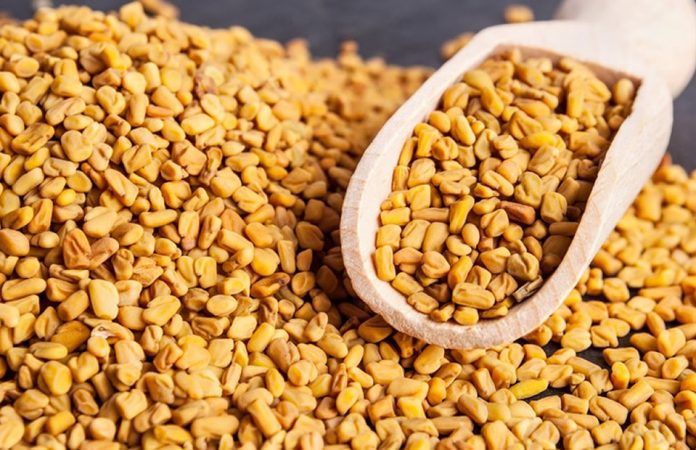Fenugreek is a herb with light green leaves and small white flowers. It’s of the pea family (Fabaceae). It is also known as Greek hay (Trigonella foenum-graecum). The fenugreek plant stands erect at two to three feet tall. The seed pods contain 10–20 small, flat, yellow-brown, pungent and aromatic seeds. Fenugreek is grown in North Africa, the Middle East, Egypt and India.
Fenugreek has a long history as an ingredient in traditional medicine. The seeds are the most widely used part of fenugreek, which are usually dried and ground. The leaves are often used in cooking as well.
Fenugreek is a herb with light green leaves and small white flowers. It’s of the pea family (Fabaceae). It is also known as Greek hay (Trigonella foenum-graecum). The fenugreek plant stands erect at two to three feet tall. The seed pods contain 10–20 small, flat, yellow-brown, pungent and aromatic seeds. Fenugreek is grown in North Africa, the Middle East, Egypt and India.
Fenugreek has a long history as an ingredient in traditional medicine. The seeds are the most widely used part of fenugreek, which are usually dried and ground. The leaves are often used in cooking as well.
Fenugreek has a long history as both a culinary and medicinal herb in the ancient world. It was one of the spices the Egyptians used for embalming, and the Greeks and Romans used it for cattle fodder. It also was grown extensively in the imperial gardens of Charlemagne. The first recorded use of fenugreek is described on an ancient Egyptian papyrus dated as far back as 1500 B.C
According to Dr. Richard Palmquist, chief of integrative health services at Centinela Animal Hospital in Inglewood, Calif. The Ayurvedic medicine practitioners discovered that Fenugreek has medicinal qualities thousands of years ago. It since has been used in alternative medicine in China to treat skin diseases.
In more recent years, Fenugreek has become a common household spice and is used as a thickening agent. It can also been found in products such as soap and shampoo. Its seeds and powder are also used in many Indian and Asian recipes for their nutritional profile and slightly sweet, nutty taste.
Fenugreek is taken for digestive problems such as loss of appetite, upset stomach, constipation, inflammation of the stomach (gastritis). Fenugreek is also used for diabetes (Fenugreek appears to slow absorption of sugars in the stomach and stimulate insulin), painful menstruation, polycystic ovary syndrome, and obesity. It is also used for conditions that affect heart health such as “hardening of the arteries” (atherosclerosis) and for high blood levels of certain fats including cholesterol and triglycerides.
Fenugreek can be used to form a paste that is applied to the skin to help heal inflammation. In manufacturing, fenugreek extracts are can be found in soaps and cosmetics. It also acts as a gum and an emulsifier, making it useful as a stabilizer as well as thickening agent for food. It’s also used as a spice and flavoring agent in food preparation.
As noted in the book “Essential Oils in Food Preservation, Flavor and Safety,” fenugreek extract and oil are known to possess antimicrobial, antioxidant, antidiabetic and antitumorigenic activities. Fenugreek’s soothing mucilage helps relieve a sore throat, associated pain, and cough.
Fenugreek is used for kidney ailments, a vitamin deficiency disease called beriberi, mouth ulcers, boils, bronchitis, infection of the tissues beneath the surface of the skin (cellulitis), tuberculosis, chronic coughs, chapped lips, baldness, cancer, Parkinson’s disease, and exercise performance. It controls boils, bronchitis, infection of the tissues beneath the surface of the skin, tuberculosis. This reduces external inflammation and can treat pain and swelling in the muscles and lymph nodes, gout, wounds, leg ulcers, sciatica, dandruff, eczema. It minimises symptoms of menopause in women.
Some men use fenugreek for hernia, erectile dysfunction (ED), male infertility, and other reproductive problems.
Women who are breast-feeding sometimes use fenugreek to promote milk flow.
Fenugreek is sometimes used as a poultice. That means it is wrapped in cloth, warmed, and applied directly to the skin to treat local pain and swelling (inflammation), muscle pain, pain and swelling of lymph nodes (lymphadenitis), pain in the toes (gout), wounds, leg ulcers, and eczema.
Fenugreek has been proved to increase appetite, which results in restorative and nutritive properties. In foods, fenugreek is included as an ingredient in spice blends. It is also used as a flavouring agent in imitation maple syrup, foods, beverages, and tobacco.
Safety and Side Effects
It lowers blood sugar levels. However, it should be used with caution. If you are on diabetes medication or other supplements that lower blood sugar levels. It’s always a good idea to check with a medical practitioner before starting a new supplement. Most importantly, ensure that you’re taking a safe dose.



























